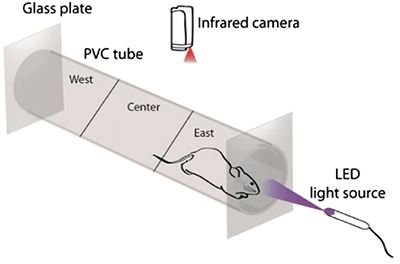New Chemical Allows Blind Mice to See
A new synthetic replacement for rod and cone cells may someday bring vision to those with macular degeneration or inheritable forms of blindness
/https://tf-cmsv2-smithsonianmag-media.s3.amazonaws.com/filer/20120726014042Lab_mouse_mg_small.jpg)
Three blind mice. Or, for experimental robustness, a few dozen more. In either case, scientists from the University of California, Berkeley, recently accomplished something seemingly impossible: By injecting a tiny amount of a specially-formulated chemical into their eyes, they temporarily restored the mice’s ability to see.
Electronic retinal implants and genetic modifications to help blind people see have been the subject of experiments for several years. But this new chemical, described in a paper published yesterday in the journal Neuron, opens up an entirely novel, flexible approach to restoring vision.
“The advantage of this approach is that it is a simple chemical, which means that you can change the dosage, you can use it in combination with other therapies, or you can discontinue the therapy if you don’t like the results,” said Berkeley professor Richard Kramer in a press release. “As improved chemicals become available, you could offer them to patients. You can’t do that when you surgically implant a chip or after you genetically modify somebody.”
In a healthy eye, when rod- and cone-shaped photoreceptor cells in the retina are struck by light, they transmit the signal to an underlying network of nerves, which ultimately send the message to the brain. But the eyes of many affected by blindness—including those with age-related macular degeneration or retinitis pigmentosa, the most common inherited form of blindness—are without functional rod and cone cells.
To restore sight, the research team synthesized a chemical called AAQ (for acrylamide-azobenzene-quaternary ammonium) with a pair of very special properties: It binds to the nerve cells in the retina and is sensitive to light. As a result, it is able to serve as a synthetic replacement for rods and cones, attaching to pores on the surface of nerve cells and activating them with an electrical impulse when struck by light.
In order to test the effectiveness of AAQ, the researchers raised a group of mice with a genetic mutation that caused their rod and cone cells to die off at an early age. Initially, when they put the mice in a PVC tube with an LED light source at one end and darkness at the other, the mice showed no location preference.

Next, the team injected a tiny amount of AAQ into the eyes of some mice, while leaving others untouched. When they were put back in the tube, the former group scurried away from the light quickly, while the latter just stayed put. The chemical’s effect was further confirmed by the fact that the experimental group’s pupils contracted under the light, while the control group’s remained the same.
The molecule binds to the retinal neuron cells temporarily, so right now, the remedy only restores sight for a matter of hours. It also probably just provides low-grade vision—the molecule’s ability to activate the retinal nerves seems to decline in dim light.
Still, the researchers are already at work developing improved forms of AAQ which would last for days, and see great potential for the chemical long-term. ”The photoswitch approach offers real hope to patients with retinal degeneration,” said Russell Van Gelder of the University of Washington. “We still need to show that these compounds are safe and will work in people the way they work in mice, but these results demonstrate that this class of compound restores light sensitivity to retinas blind from genetic disease.”
/https://tf-cmsv2-smithsonianmag-media.s3.amazonaws.com/accounts/headshot/joseph-stromberg-240.jpg)
/https://tf-cmsv2-smithsonianmag-media.s3.amazonaws.com/accounts/headshot/joseph-stromberg-240.jpg)